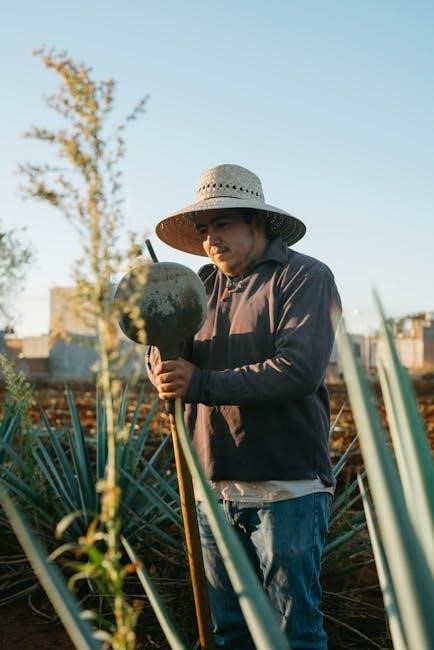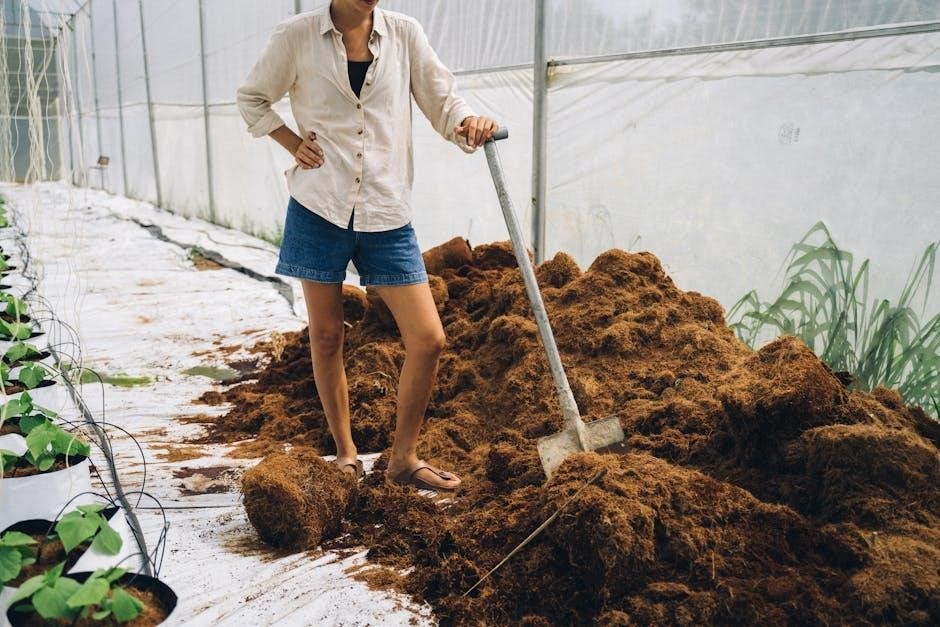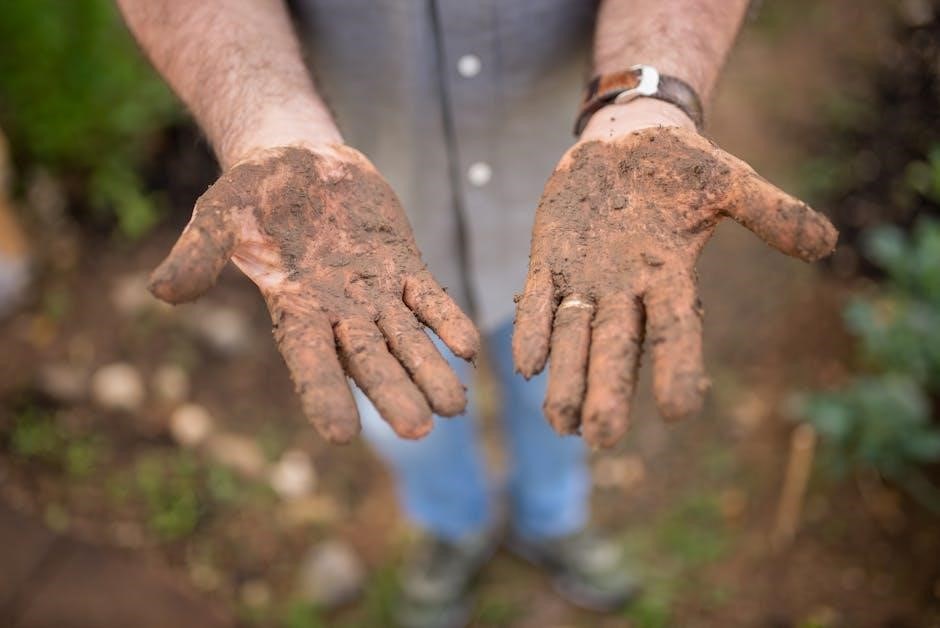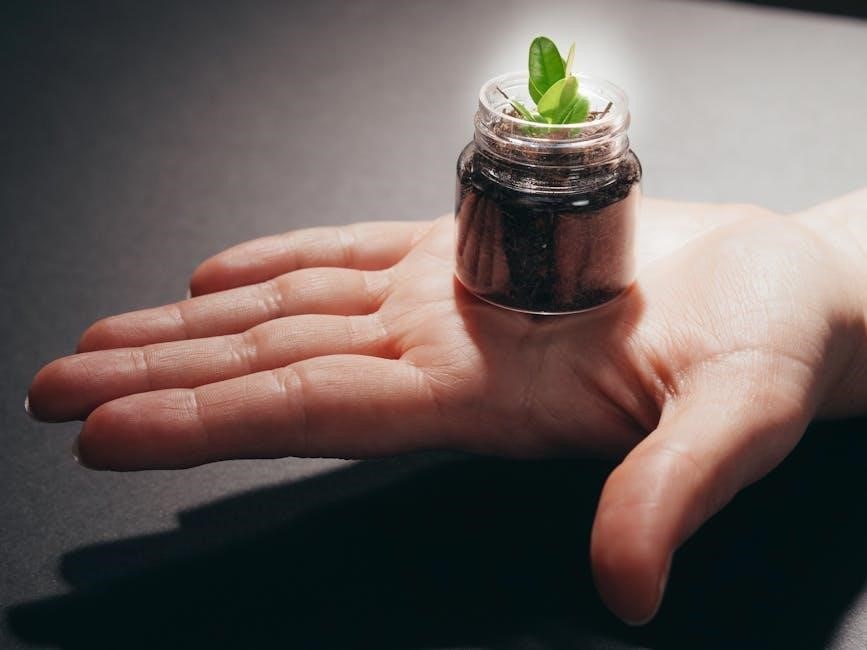Soil compaction is a process of densifying soil to enhance stability and strength. It involves reducing air pockets to create a firm base for construction or landscaping. Manual methods are cost-effective for small-scale projects. Proper techniques ensure even density, preventing erosion and settling. This guide covers practical steps for achieving optimal compaction manually.
1.1 Importance of Soil Compaction
Soil compaction is crucial for creating a stable and durable base for construction, landscaping, and agriculture. It enhances soil strength, reduces settling, and prevents erosion. Proper compaction ensures even load distribution, making it essential for foundational structures. Manual compaction is cost-effective and suitable for small-scale projects, offering precise control over soil density and texture, which is vital for plant growth and structural integrity.
1.2 Brief Overview of Manual Compaction Methods
Manual soil compaction involves techniques like tamping, stomping, or using handheld tools such as tampers or plate compactors. Water can be added to optimize moisture levels, enhancing compaction efficiency. Foot traffic and simple tools are often sufficient for small-scale projects. These methods are cost-effective and environmentally friendly, providing precise control over soil density without heavy machinery, making them ideal for gardens, pathways, and small construction sites.
Understanding Soil Types and Their Compaction Needs
Soil types vary in texture and density, affecting compaction methods. Clay soils are dense and cohesive, while sandy soils are loose and permeable. Silt and loam soils fall between these extremes. Each type requires specific techniques for optimal compaction, ensuring stability and preventing erosion. Understanding your soil type is crucial for effective manual compaction, as different soils respond differently to pressure and moisture.
2.1 Identifying Soil Types (Clay, Silt, Sand, Loam)
Soil types are categorized based on texture and particle size. Clay soils are dense and cohesive, holding water well. Silt soils are finer, often feeling smooth and less gritty. Sandy soils are coarse, drain quickly, and lack cohesion. Loam soils balance clay, silt, and sand, offering good drainage and fertility. Identifying your soil type is essential for determining the best compaction approach and achieving desired results in manual compaction efforts.
2.2 Moisture Content and Its Role in Compaction
Moisture content significantly impacts soil compaction efficiency. Optimal moisture levels vary by soil type but typically range between 10-20% for manual compaction. Excess water can lead to instability, while overly dry soil resists densification. Testing moisture by squeezing a soil sample helps determine readiness. Proper moisture ensures particles bond effectively, enhancing strength and stability in the compacted surface for durable results.
Tools and Equipment for Manual Soil Compaction
Manual soil compaction relies on tools like hand tampers, plate compactors, and utilizing water. Foot traffic also aids in achieving the desired density for a stable base.
3.1 Hand Tamper and Plate Compactor
A hand tamper is a small, portable tool used for compacting soil in confined spaces. Its flat base allows for targeted pressure. A plate compactor, while larger, is still manual and effective for denser layers. Both tools reduce air pockets, ensuring a stable base. Regular use of these tools enhances soil strength and prevents settling over time.
3.2 Using Water and Foot Traffic for Compaction
Water and foot traffic are simple yet effective manual compaction methods. Water helps soften the soil, reducing internal friction between particles. Foot traffic involves repeatedly walking over the soil to apply pressure, forcing air out and increasing density. These methods are cost-effective and require minimal equipment, making them ideal for small-scale projects. However, they can be time-consuming for larger areas.

Preparing the Soil for Compaction
Soil preparation involves clearing debris, leveling the ground, and ensuring optimal moisture levels. Adding organic matter or aggregates can improve soil structure for better compaction results.
4.1 Clearing Debris and Leveling the Ground
Clearing debris like rocks, twigs, and roots ensures a smooth surface for compaction. Leveling the ground with a rake or shovel promotes even density. For larger areas, use a spade or blade to create a uniform base. Check the surface with a spirit level or by eye to confirm it’s even. Uneven ground can lead to poor compaction and instability, so precision is key in this step.
4.2 Adding Organic Matter or Aggregate Materials
Mixing in organic matter like compost or peat moss improves soil structure and drainage. Aggregate materials such as sand or gravel enhance stability and prevent settling. Spread these uniformly across the soil surface before compaction. Use a shovel or trowel for small areas, ensuring the mix is well-integrated. This step boosts the soil’s load-bearing capacity and ensures a durable base for landscaping or construction projects. Proper mixing is essential for optimal results.

Manual Compaction Techniques
Manual compaction involves using tools like hand tampers or heavy objects to press down soil, removing air pockets for stability. Techniques include tamping, foot pressing, and watering to optimize soil density. Working in layers ensures even compaction, crucial for small-scale projects. Safety is key, with protective gear recommended to prevent injuries during the process.
5.1 Tamping with a Hand Tool
Tamping with a hand tool, such as a tamper or plate compactor, is an effective method for manual soil compaction. Hold the tool firmly and press down with consistent force, ensuring even pressure across the surface. Repeat the process in overlapping passes to achieve uniform density. This technique is ideal for small areas and ensures a stable base, reducing settling over time. Regularly inspect the tool for wear to maintain effectiveness.
5.2 Using Body Weight for Foot Compaction
Foot compaction utilizes body weight to press down soil, effectively reducing air pockets. Wear sturdy boots and stand with feet shoulder-width apart. Slowly press down, shifting weight onto the heels, then lift. Repeat in small sections for consistent results. This method is simple, cost-effective, and ideal for small-scale projects, ensuring a firm and stable soil surface without specialized tools.

Best Practices for Effective Compaction
Effective manual compaction requires consistent effort and attention to detail. Work in uniform layers, avoid over-compacting, and maintain optimal moisture levels for best results and stability.
6.1 Working in Layers for Even Compaction
Working in layers ensures even compaction by dividing the soil into manageable depths. Start with a thin layer, compact it thoroughly, then progress to the next. This method prevents uneven settling and promotes uniform density. It’s essential to maintain consistent moisture levels across each layer for optimal results and long-term stability.
6.2 Avoiding Over-Compaction and Its Consequences
Over-compaction occurs when soil is compressed beyond its optimal density, reducing porosity and water infiltration. This can hinder root growth and lead to soil instability. Recognizing the signs, such as excessive hardness or water pooling, is crucial for preventing damage.
Avoid over-tamping by monitoring progress and stopping when the desired firmness is achieved. Using the right tools and techniques helps maintain soil health and structure.

Testing the Compaction Results
Testing ensures soil compaction meets desired firmness and stability. Methods include the foot test for surface hardness and visual checks for evenness and water absorption.
7.1 Using the “Foot Test” for Firmness
The “foot test” is a simple method to assess soil firmness post-compaction. Press your foot firmly into the soil; minimal indentation indicates proper compaction. For optimal results, the soil should feel solid and resist deformation. Repeat the test across the area to ensure uniform density and consistency. This practical check helps verify if manual compaction has achieved the desired stability for the intended use.
7.2 Checking for Evenness and Stability
After compaction, inspect the soil surface to ensure evenness and stability. Use a spirit level or straightedge to check for uniformity. Walk across the area to test firmness; it should feel solid and unyielding. Any soft spots indicate incomplete compaction. Achieving evenness and stability ensures the surface is prepared for its intended use, whether for construction or landscaping, providing a durable and reliable base.
Safety Tips for Manual Compaction
Wear protective gear like gloves and sturdy footwear. Use proper lifting techniques to avoid injury. Stay hydrated and take breaks to prevent fatigue during manual compaction tasks.
8.1 Preventing Fatigue and Injury
Take regular breaks to avoid muscle strain. Use stretching exercises to maintain flexibility. Wear proper footwear and gloves to reduce impact. Ensure tools are ergonomic and suited to your strength. Avoid overexertion by pacing tasks and staying hydrated. Proper lifting techniques, like bending at the knees, can prevent back injuries. Prioritize rest to maintain energy levels and focus during manual compaction work.
8.2 Wearing Protective Gear
Always wear protective gear to ensure safety during manual soil compaction. Use sturdy gloves to protect hands from cuts and blisters. Safety glasses shield eyes from debris. Steel-toe boots prevent foot injuries from tools or heavy objects. A dust mask reduces inhalation of soil particles. Proper gear minimizes risks and ensures a safer working environment for effective compaction tasks.

Common Mistakes to Avoid
Common mistakes include over-compacting, which can damage soil structure, and not preparing soil properly. Using inappropriate tools or incorrect techniques also leads to ineffective compaction and instability.
9.1 Compacting Dry or Saturated Soil
Compacting dry or overly saturated soil is ineffective, as it fails to achieve proper density. Dry soil lacks cohesion, while saturated soil becomes prone to settling. Ideal moisture levels, typically between 15-20%, ensure soil particles bind well. Compacting outside this range leads to uneven surfaces and instability. Always test soil moisture before starting manual compaction to avoid these issues.
9.2 Ignoring Soil Type-Specific Needs
Ignoring soil type-specific needs is a common mistake that leads to poor compaction results. Clay, silt, sand, and loam require different handling. Clay soils need careful moisture control to avoid over-compaction, while sandy soils may require more vigorous tamping. Failing to adapt techniques to soil type results in uneven density, instability, and settling issues. Always assess soil type before beginning manual compaction for optimal outcomes.
Mastering manual soil compaction enhances stability and durability in projects. Proper techniques and moisture management ensure long-lasting results. Practice and patience yield professional-grade outcomes every time.
10.1 Summary of Key Points
Manual soil compaction involves understanding soil types, moisture levels, and proper tools. Techniques like tamping and foot compaction ensure even density. Working in layers avoids over-compaction. Testing firmness and stability confirms results. Safety and avoiding common mistakes are crucial for success. Proper preparation and execution yield durable, stable soil surfaces for various applications.
10.2 Final Tips for Successful Manual Compaction
Consistently apply even pressure and maintain optimal moisture levels. Use the right tools for your soil type to save time and effort. Avoid over-compaction to prevent soil damage. Regularly check progress and adjust techniques as needed. Monitor for cracks or soft spots and address them promptly; Patience and thorough effort will yield a stable, long-lasting result for your manual compaction project.

Additional Resources
For further learning, consider A Practical Guide to Manual Soil Compaction, a cornerstone textbook. Explore tutorial videos and a Dictionary of Soil Science for comprehensive understanding.
11.1 Recommended Tools and Tutorials
For manual soil compaction, essential tools include hand tampers and plate compactors. Tutorials like YouTube video guides and step-by-step manuals provide practical insights. Check out A Practical Guide to Manual Soil Compaction for detailed instructions. Additionally, online courses and DIY soil compaction kits can enhance your skills. These resources ensure effective and efficient soil compaction for various projects.
11.2 Further Reading and Expert Advice
For deeper insights, explore publications like A Practical Guide to Manual Soil Compaction and expert tutorials on platforms like YouTube. These resources offer comprehensive techniques and troubleshooting tips. Additionally, consult Soil Mechanics for Beginners to understand foundational principles. Engaging with gardening forums and seeking advice from landscapers can also enhance your manual compaction skills effectively.